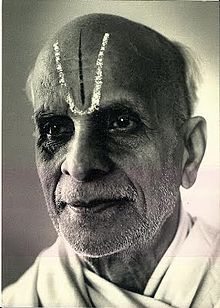Rallapalli Ananta Krishna Sharma
This article may require copy editing for grammar, style, cohesion, tone, or spelling. (August 2023) |
Rallapalli Ananta Krishna Sharma | |
|---|---|
 | |
| Born | 23 January 1893 Rallapalli, Kambadur taluq, Anantapur district, Andhra Pradesh |
| Died | 11 March 1979 (aged 86) Bangalore, Karnataka |
| Occupation | Telugu pandit |
| Genre | Composer, Writer, Scholar |
| Subject | Carnatic Music, Telugu, Kannada, Samskrit & Prakrit |
| Notable awards | Sangita Kalanidhi |
| Spouse | Rukminamma |
| Children | R A Phani Shayi, R A Jayanta, Smt Nagamani, Smt Prabhavati & Smt Harini |
| Website | |
| Rallapalli Ananta Krishna Sharma | |
Rallapalli Ananta Krishna Sharma (Telugu: రాళ్ళపల్లి అనంతకృష్ణశర్మ) (23 January 1893 – 11 March 1979) was a noted composer of Carnatic music, singer, Telugu litterateur, teacher and Sanskrit scholar. He was responsible for discovering, cataloguing and putting to music many forgotten compositions of Annamacharya.[1] These compositions composed hundreds of years agearlierame back to life thanks to Sharma's efforts and successive singers like S. P. Balasubramanyam and M. S. Subbalakshmi would sing many of them, hence popularising them.[2][3] Sharma authored prose works like Vemana, Natakopanyasamulu,[4] Ganakale,[5] Sahitya Mattu Jeevana Kale and Saraswatalokamu.[6][7] Rallapalli Ananta Krishna Sharma translated 395 (out of 700) Gathas from original Prakrit into Telugu language titled Shalivahana Gatha Sapta Saramu[8] in 1931. Sharma is the recipient of Central Sangeet & Natak Academy Fellowship (1973), Gana Kala Sindhu (1961), Gana Kala Prapoorna (1969), Sangeeta Kala Ratna (1974) and Sangeeta Sahitya Asthan Vidwan honours with an Honorary Doctorate from TTD University, Andhra Pradesh.[9]
Early life

Rallapalli Ananta Krishna Sharma was born on 23 January 1893 to parents Karnamadakala Krishnamacharya and Alamelu Mangamma. He was born in Rallapalli village in Kambadur taluk, Anantapur district, Andhra Pradesh.[1][2] Sharma and his sister Yadugiramma used to sing religious hymns inside the local fort at Rallapalli. Sharma arrived in Mysore in 1905 at the age of twelve years and spent a year at Parakala Matha under the aegis of Krishnabrahmatantra Swamy. Sharma helped the Swamy in bringing out 'Alankara Manihara' - a treatise on Alankara Sastra. After his tenure at Parakala Matha, he went to Pandit Ramashastry in Chamarajanagar to learn Sanskrit.[10] Later, in 1911, he married Rukminamma. Sharma lacked formal college or University education, but his proficiency in the traditional Sastras and musical compositions became his main strength. Rallapalli Ananta Krishna Sharma composed his first Sanskrit composition at the age of 14 years. It was a composition dedicated to Goddess Lakshmi titled 'Jalarashi Balelole'.[11]
Musical Training

While in Mysore, Sharma frequented Carnatic musical concerts by Veena Seshanna, Veena Subbanna, Karigiraya, Mysore Vasudevacharya, Bidaram Krishnappa and Chikka Ramaraya. His repeated attempts at persuading these maestros to take him as a formal student of music were unsuccessful. Finally, Bidaram Krishnappa agreed to teach Carnatic music to Rallapalli Ananta Krishna Sharma. Krishnappa convinced Sharma not to participate in public expositions of his music in concerts and so on.[2] Even when Muthiah Bhagavatar wanted to arrange a private concert for the ruling Maharaja of Mysore - Nalwadi Krishna Raja Wodeyar, Sharma declined it.
Teacher

Sharma was appointed a Telugu Pundit (a scholar) by Sir
Major works
- Ananta Bharati (collection of Sanskrit works)
- Meerabai (1913) (Telugu Khanda Kavya)
- Taradevi (1911) (Telugu Khanda Kavya)
- Vemana Natakopanyasamulu (1928–29)
- Shalivahana Gatasaptashati Saramu (1932) (translation work from the Prakrit into Telugu)
- Saraswatalokamu (1954)
- Chayapa Senaniya, Nrita Ratnavali (1969) (Translation into Telugu)
- Arya (1970) (Translation of Sanskrit work of Sundara Pandya into Telugu)
- Natakopanyasamulu
Literary works in Kannada
- Ganakale (1952),
- Sahitya Mattu Jeevana Kale (1954 )
- a few published talk.
Awards
- He was honored as "Astana Vidwan" by Tirumala Tirupati Devasthanams in 1979
- "Sangita Kalanidhi" in 1974
- Honorary Doctorate (D.Litt.) by Sri Venkateswara University, Tirupathi in 1974
- "Ganakala Sindhu" at Sangeeta Sammelan organized by Sri Prasanna Seetarama Mandiram, Mysore in 1961
- "Gana Kala Prapurna" by Andhra Pradesh Sangeeta Nataka Academy
- "Sangeeta Kalaratna" by Bangalore Gayana Samaj
Birth Centenary
Sharma died on 11 March 1979 in
References
- ^ a b Anantha Krishna Sharma Rallapalli, Luminaries of 20th Century, Part I, Potti Sriramulu Telugu University, Hyderabad, 2005, pp: 8-9.
- ^ a b c "Rallapalli Ananta Krishna Sharma | Dr. S. Srikanta Sastri - Official Website". Dr.S.Srikanta Sastri. Retrieved 17 March 2023.
- ^ "Tāḷlapāka Annamayya pāṭalu | WorldCat.org". www.worldcat.org. Retrieved 17 March 2023.
- ^ "Nāṭakōpanyāsamulu | WorldCat.org". www.worldcat.org. Retrieved 17 March 2023.
- ^ "ಗಾನಕಲೆ | WorldCat.org". www.worldcat.org. Retrieved 17 March 2023.
- ^ "Sārasvatālōkamu | WorldCat.org". www.worldcat.org. Retrieved 17 March 2023.
- ^ "రాళ్ళపల్లి అనంతకృష్ణశర్మ | తెలుగుబిడ్డ". www.telugubidda.in. Retrieved 17 March 2023.
- ^ "Śālivāhana gāthā saptaśatī sāramu | WorldCat.org". www.worldcat.org. Retrieved 17 March 2023.
- ^ "SNA: List of Sangeet Natak Akademi Ratna Puraskarwinners (Akademi Fellows)". Official website. Archived from the original on 6 December 2014.
- ^ He turned the spotlight on Annamayya by Sriram Venkata Krishnan in The Hindu.
- ^ "శ్రీ రాళ్ళపల్లి అనంతకృష్ణ శర్మ | ఆదర్శమూర్తులు". Sirimalle. 1 February 2020. Retrieved 17 March 2023.
- ^ "Archived copy". Archived from the original on 14 July 2011. Retrieved 30 September 2010.
{{cite web}}: CS1 maint: archived copy as title (link)
